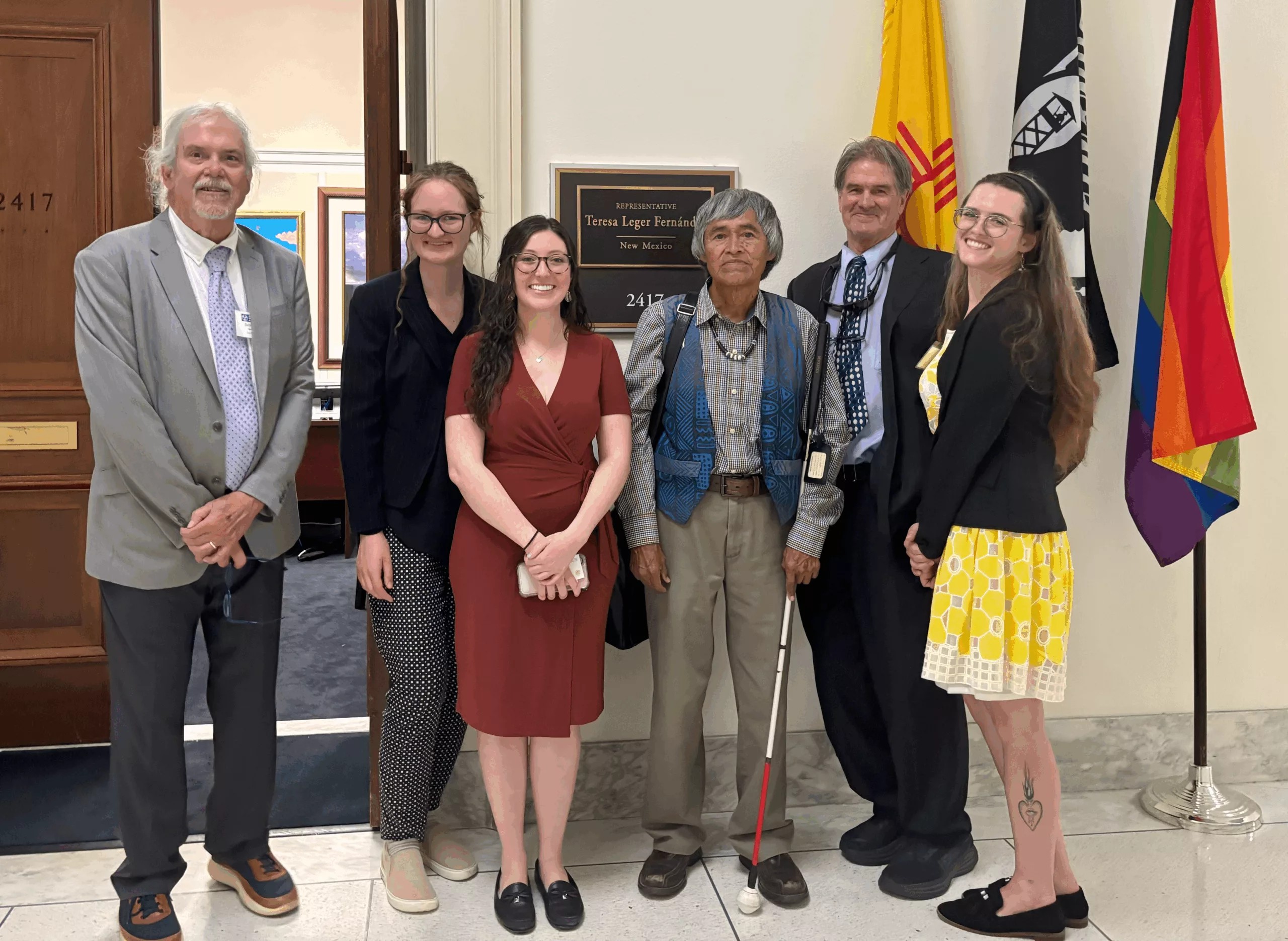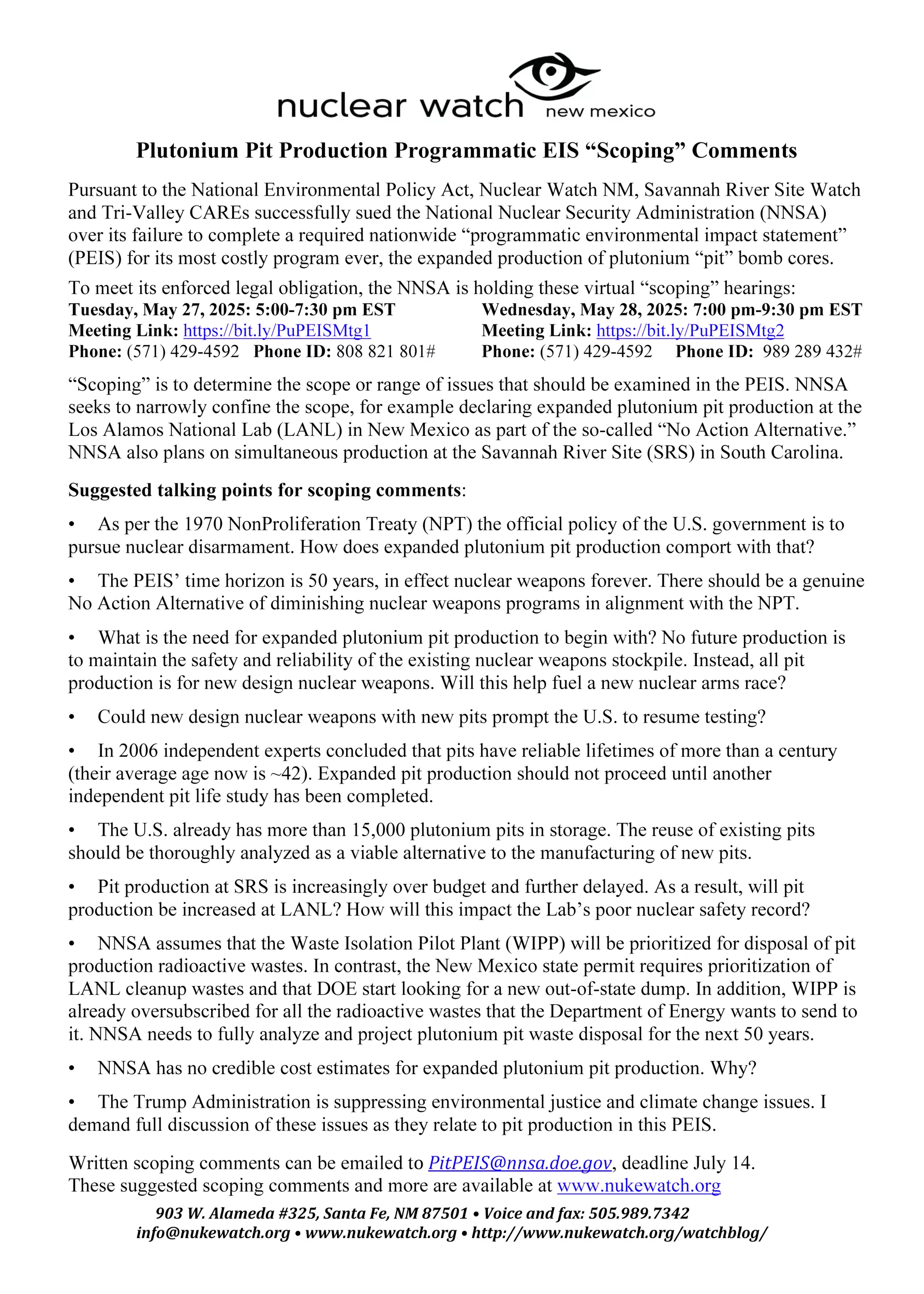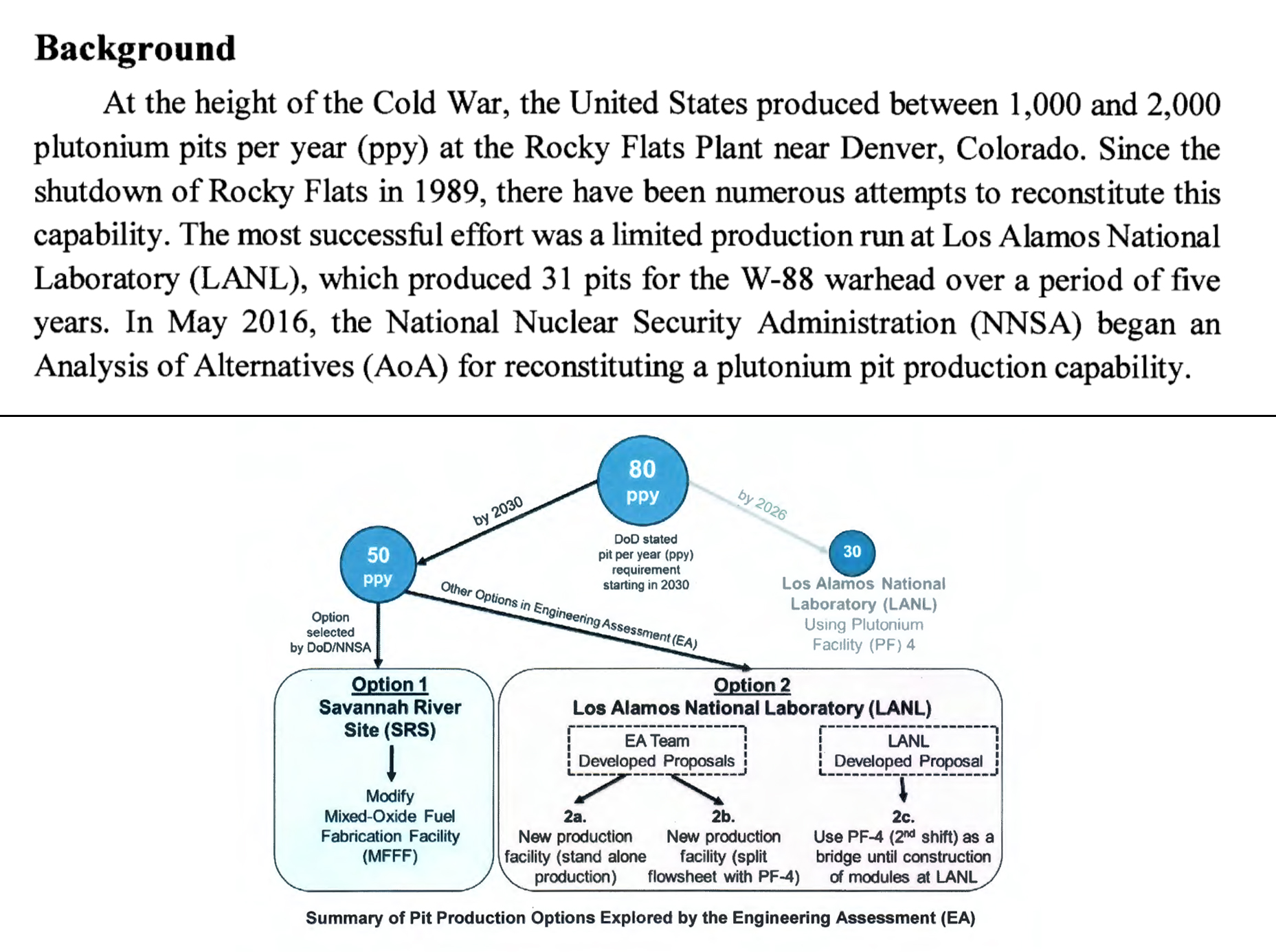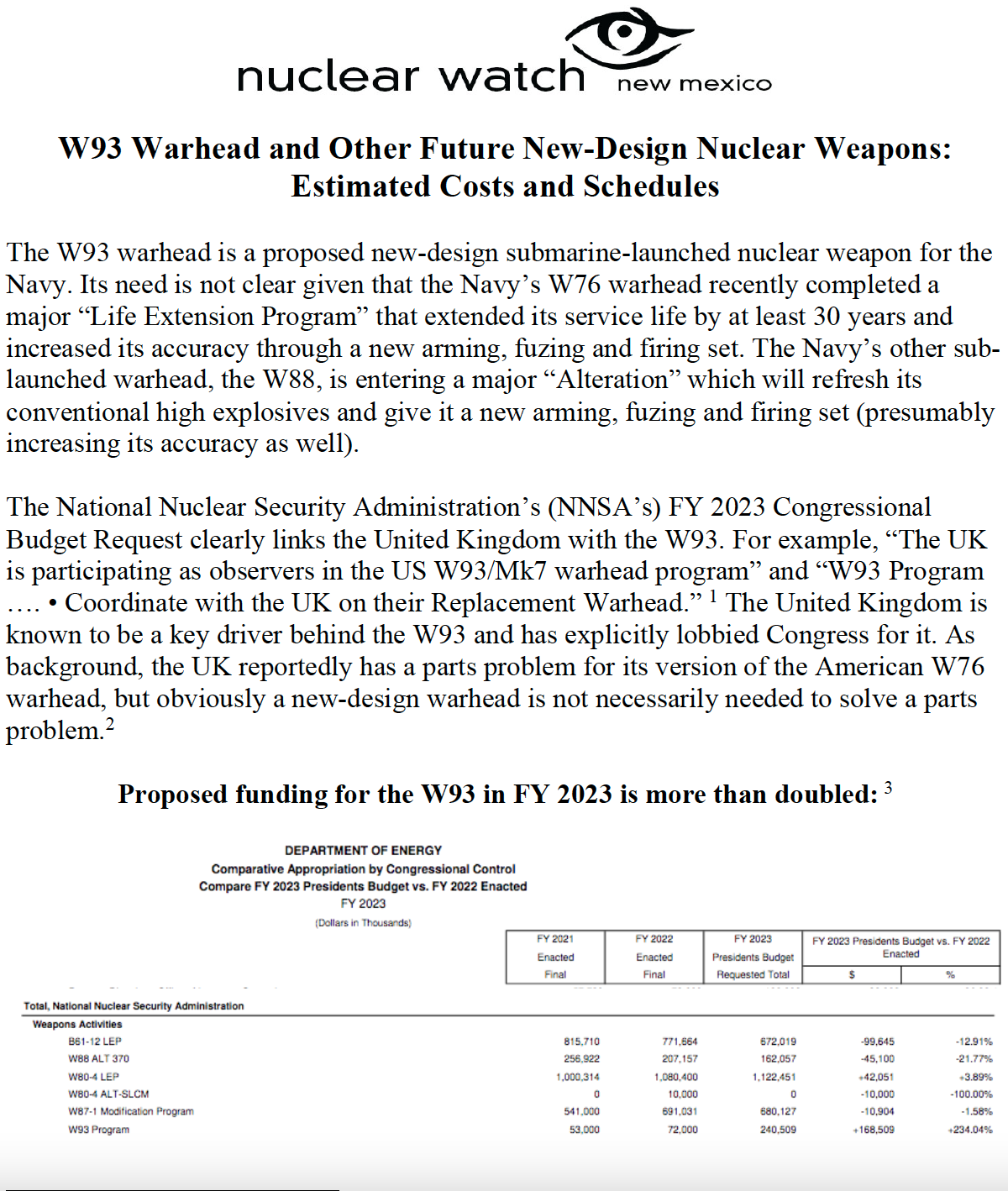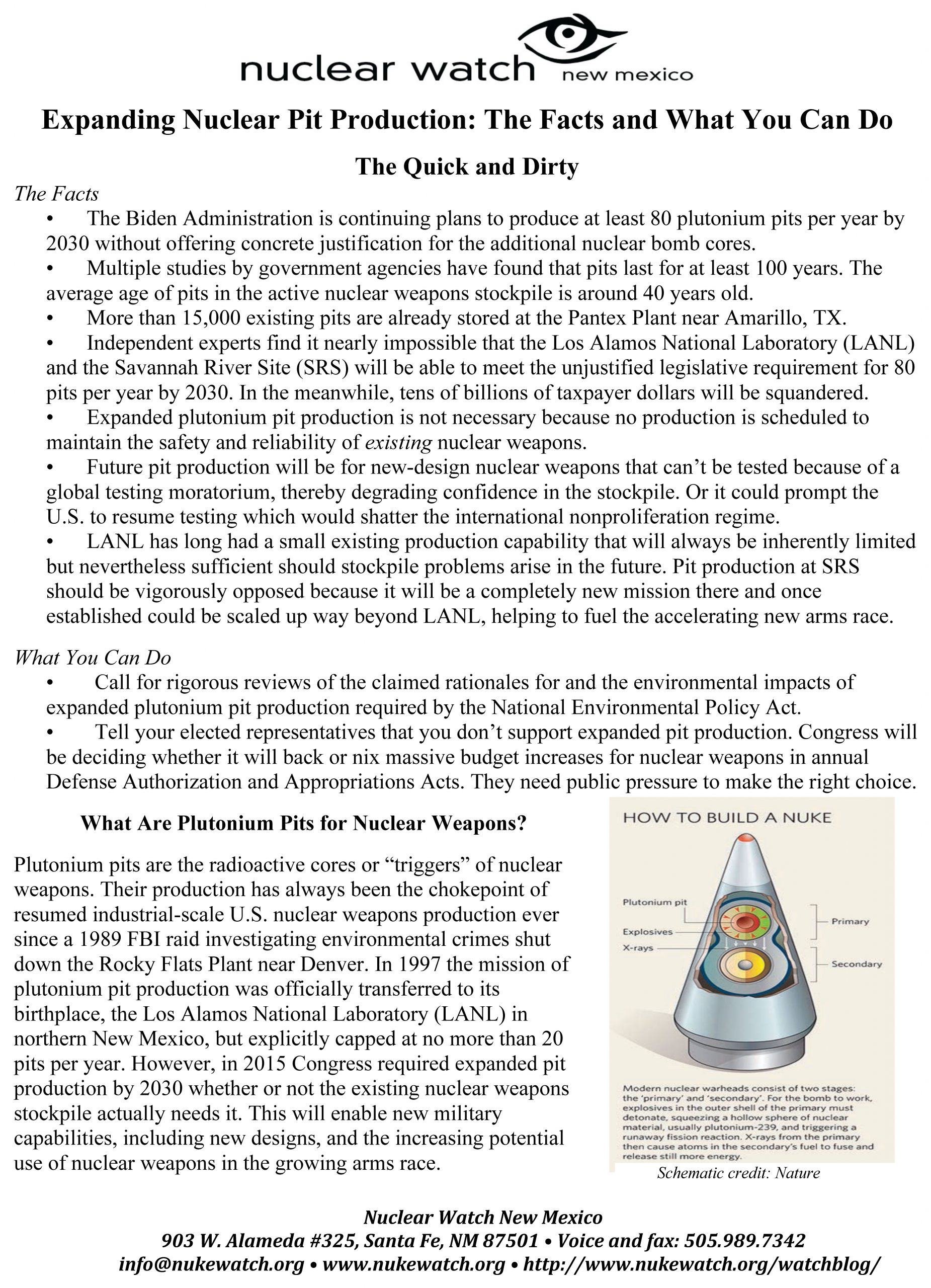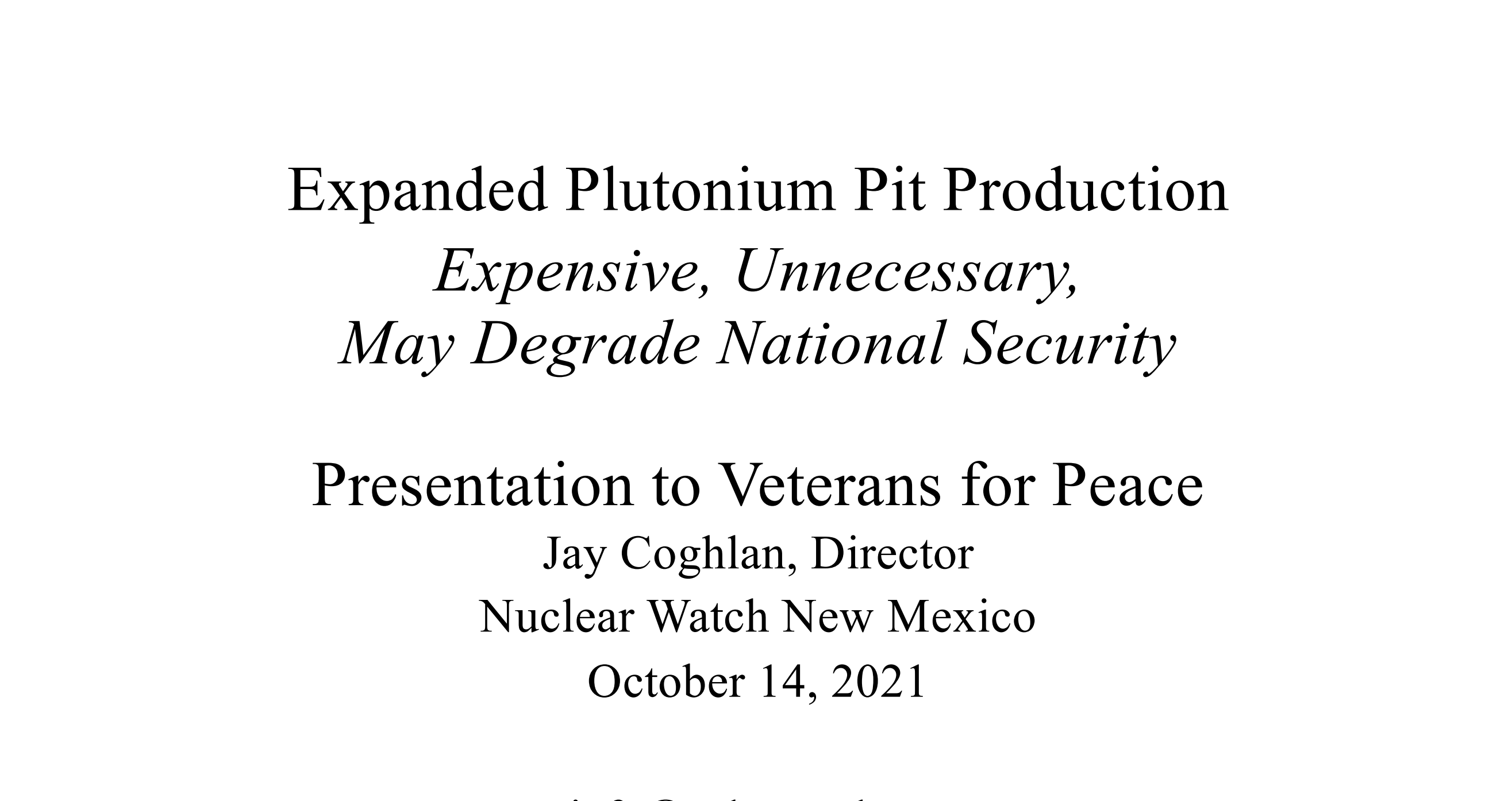Updates
NukeWatch in DC Lobbying for Nuclear Disarmament and Non-Proliferation
Your Nuclear Watch New Mexico team has just returned from a weeklong trip to Washington D.C. (we went so you don’t have to!). The Alliance for Nuclear Accountability (ANA) hosts an annual “DC Days” conference and following Spring Meeting, and we proudly joined as part of a record number of groups this year. Over 60 individuals from 30+ organizations journeyed to DC to lobby congress on nuclear weapons, energy, and waste policy on behalf of the frontline nuclear communities we represent. Members were present from groups representing the entire U.S. nuclear complex, including sites in Georgia, New Mexico, Tennessee, California, Missouri, Colorado, Idaho, Nevada and beyond. NukeWatch NM brought all three staff members—Jay Coghlan, Scott Kovac, and Sophia Stroud (whose participation was made possible by a youth scholarship from ANA)—to participate in DC Days and the subsequent two-day spring meeting. The ANA DC Days schedule included over 70 meetings with senators, representatives, and other relevant agencies, such as the Department of Energy, the Government Accountability Office, and the Defense Nuclear Facilities Safety Board. Our NukeWatch team attended nearly 30 of these meetings. The Alliance for Nuclear Accountability put together a new report to present our “asks” to congress as a coalition, including analysis and recommendations for nuclear weapons, nuclear waste, and nuclear energy policy and funding. Please click HERE for the full report, and HERE for a short summary.
I was glad to see increased representation from Nevada this year, and especially Indigenous representation. In light of the current administration’s attacks on Environmental Justice, it is more important than ever that ANA as a whole, as well as individual member groups, continue to prioritize uplifting Native American voices, not only because of their deep cultural, spiritual, and social connections to the land, including sacred sites and traditional knowledge essential to religious freedom and access, but also because of the violent legacy and ongoing reality of nuclear colonialism, in which Indigenous lands and peoples have been deliberately and disproportionately targeted in the nuclear industry with uranium mining, nuclear weapons testing and production, and the disposal of radioactive waste. To learn more about Nuclear Colonialism, see: www.networkadvocates.org/downwinders and read Nuclear Nuevo México: Colonialism and the Effects of the Nuclear Industrial Complex on Nuevomexicanos by Myrriah Gómez.
Plutonium Pit PEIS Scoping Hearing Presentation: Slides and Recording
Get Prepared: A coalition of advocacy groups, including Union of Concerned Scientists, Tri-Valley CAREs, and NukeWatch New Mexico recently held a training to help participants prepare effective comments.
Watch the recording here
Password: gP=&0LYZ
Plutonium Pit Production Programmatic EIS “Scoping” Comments
Formal Comments on the Draft Site-Wide Environmental Impact Statement for Continued Operation of the Los Alamos National Laboratory
The National Environmental Policy Act requires the Los Alamos National Laboratory to periodically prepare a new “Site-Wide Environmental Impact Statement (SWEIS) for Continued Operations.”
Please use NukeWatch NM’s recent extensive comments on the Lab’s new draft SWEIS as a resource and citizens’ guide to Lab issues.
Did you know, for example, that:
• LANL’s nuclear weapons production budget has doubled over the last decade?
• The Lab’s so-called cleanup plan is to “cap and cover” some 200,000 cubic yards of radioactive and toxic waste, leaving them permanently buried as a perpetual threat to groundwater?
• There is a planned intentional release of up to 30,000 curies of radioactive tritium gas, all without a public hearing?
Use our lengthy formal comments as a starting point, toolkit or resource for dissecting ongoing and future issues at LANL!
We encourage you to use our comments to ask for follow-up info, either from us here at NukeWatch or from the Lab, and to demand better accountability and transparency! Use as background or briefing material for local and congressional advocacy.
For example:
- Cite or excerpt our comments in future public processes under the National Environmental Policy Act. For example, we are expecting that a nationwide programmatic environmental impact statement for plutonium “pit” bomb core production will be announced soon, the result of a lawsuit in which NukeWatch led.
- Share with those organizing around stopping expanded plutonium pit production and advocating for genuine radioactive and toxic wastes cleanup.
- Learn about LANL’s proposed electrical transmission line across the environmentally and culturally sensitive Caja del Rio and alternatives that were not considered.
- The National Environmental Policy Act itself is under assault by the Trump Administration. We expect environmental justice and climate change issues to be stripped from LANL’s final Site-Wide Environmental Impact Statement. This needs to be resisted!
NukeWatch NM argued that the draft SWEIS should be withdrawn and a new one issued because:
• The NNSA has rigged the draft LANL Site-Wide EIS with three self-serving scenarios:
– Expanded nuclear weapons programs (contradictorily called the “No Action Alternative”).
– Yet more expanded nuclear weapons programs (“Modernized Operations Alternative”).
– Yet far more expanded nuclear weapons programs (“Expanded Operations Alternative”).
• A Reduced Operations Alternative must be included.
• The SWEIS’ fundamental justification for expanded nuclear weapons programs is “deterrence.” But “deterrence” has always included nuclear warfighting capabilities that could end human civilization overnight.
• The SWEIS purports to align with U.S. obligations under the 1970 NonProliferation Treaty. That is demonstrably false.
• Future plutonium pit production is NOT to maintain the safety and reliability of the existing nuclear weapons stockpile. Instead, it is for new-design nuclear weapons that could lower confidence in stockpile reliability and/or prompt a return to testing.
• The SWEIS’ No-Action Alternative violates the National Environmental Policy Act (NEPA).
• The legally required programmatic environmental impact statement on pit production should be completed first, followed by the LANL SWEIS.
• Plutonium pit reuse should be analyzed as a credible alternative to pit production.
• A recent proposal for a data center at LANL is not in the SWEIS. It raises huge issues of future water and electrical use, the appropriateness of commercial interests at a federal lab, and the possible fusion of artificial intelligence and nuclear weapons command and control.
• Recent Executive Orders could strip the final SWEIS of environmental justice and climate change analyses. This must have clarification.
• Planned tritium releases should be fully analyzed.
• The Electrical Power Capacity Upgrade should be analyzed will all credible alternatives.
• The proposed BioSafety Level-3 facility must have its own standalone EIS.
• All Defense Nuclear Facilities Safety Board concerns should be addressed and resolved.
• Genuine comprehensive cleanup should be a preferred alternative.
• A new SWEIS should follow a new overdue Probabilistic Seismic Hazard Analysis.
NukeWatch Los Alamos Lab Site-Wide EIS Workshop – February 6, 2025
Full Video Recording: NukeWatch Los Alamos Lab Site-Wide EIS Workshop |
NukeWatch Presentation: Los Alamos Lab Site-Wide EIS Workshop |
|---|---|
|
NukeWatch Los Alamos Lab Site-Wide EIS Workshop |
 |
Exchange Monitor: Compromise reached on pit production suit environmental review
“The National Nuclear Security Administration and environmental plaintiffs settled a lawsuit that could put a pause on plutonium pit production efforts at Savannah River Site if approved.”
By Exchange Monitor | January 29, 2025 exchangemonitor.com
The agreement, made public Jan. 16, would leave Los Alamos National Laboratory as the National Nuclear Security Administration’s (NNSA) sole pit factory until an environmental impact statement is completed as part of the National Environmental Protection Act (NEPA). The process is expected to take at least two-and-a-half years, according to the document.
Until a record of decision is issued from the environmental review, NNSA is enjoined from installing classified equipment or introducing nuclear material at the Savannah River plant, according to a press release from the citizen groups. Actual pit production at Savannah River is not expected before the 2030s, according to NNSA.
The plaintiffs alleged in the lawsuit from 2021 that NNSA and DOE would violate NEPA by producing plutonium pits at Los Alamos and Savannah River Site without conducting a proper environmental review. A federal judge agreed with the plaintiffs in September, but instigated months of back and forth between both parties by forcing them to agree to a solution themselves.
The settlement requires NNSA to produce a new programmatic environmental impact statement within two-and-a-half years. Until that is complete in a process that would include public hearings nationwide and public comment on the draft of the statement, NNSA would not be able to process nuclear material at Savannah River’s plutonium facility.
The plaintiffs in the suit include environmental watch group Savannah River Site Watch of South Carolina; Tom Clements, director of Savannah River Site Watch; The Gullah Geechee Sea Island Coalition, a group representing the interests of some descendants of enslaved Africans dwelling on the lower Atlantic coast; Nuclear Watch New Mexico of Santa Fe, N.M.; and the Tri-Valley Communities Against a Radioactive Environment, of Livermore, Calif.
Hot Plutonium Pit Bomb Redux
“Plaintiffs including Savannah River Site Watch, South Carolina Environmental Law Project Gullah/Geechee Sea Island Coalition, Nuclear Watch New Mexico and Tri-Valley CAREs forced NNSA to halt construction on many phases of its plutonium pit facility near Aiken, SC, to hold public scoping meetings, solicit public comments, and produce a Programmatic Environmental Impact Statement within thirty months.”
By Mark Muhich, Counterpunch | January 31, 2025 counterpunch.com
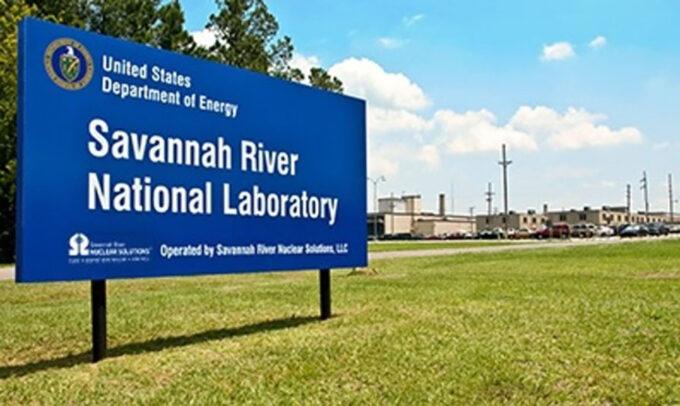
Last week U.S. District Judge Mary Lewis Geiger, South Carolina, faulted the Department of Energy and the National Nuclear Security Agency for ignoring the National Environmental Protection Act and rushing plans to fabricate plutonium pit bombs at Savannah River Site, near Aiken, South Carolina.
Newly designed plutonium pits will serve as “triggers” for the next generation of nuclear warheads mounted atop Sentinel, the next generation of intercontinental ballistic missile, and for new submarine-launched nuclear weapons. Combined, these projects comprise major components in the trillion-dollar “modernization” of the U.S. strategic deterrence force.
Continue reading
Historic Settlement Reached in NEPA Lawsuit Over Plutonium “Pit” Bomb Core Production
Nonprofit public interest groups have reached an historic settlement agreement with the Department of Energy’s semi-autonomous nuclear weapons agency, the National Nuclear Security Administration (NNSA). This is the successful result of a lawsuit against NNSA over its failure to complete a programmatic environmental impact statement on the expanded production of plutonium “pit” bomb cores, as required by the National Environmental Policy Act (NEPA). This agreement and a joint motion to dismiss have been submitted to Judge Mary Lewis Geiger of the Federal District of South Carolina. Should the Court enter the dismissal and retain jurisdiction to enforce the settlement, the agreement will go into effect.
This lawsuit was first filed in June 2021 by co-plaintiffs Savannah River Site Watch of Columbia, SC; Nuclear Watch New Mexico of Santa Fe, NM; Tri-Valley Communities Against a Radioactive Environment (CAREs), based in Livermore, CA; and the Gullah/Geechee Sea Island Coalition of coastal Georgia. NNSA promptly moved to have the case dismissed which in February 2023 Judge Lewis rejected, calling her decision “not a close call.”
In September 2024, Judge Lewis ruled that DOE and NNSA had violated NEPA by failing to properly consider alternatives before proceeding with their plan to produce plutonium pits, a critical component of nuclear weapons, at the Los Alamos National Laboratory (LANL) in New Mexico and, for the first time ever, at the Savannah River Site (SRS) in South Carolina. The Court found that the plan’s purpose had fundamentally changed from NNSA’s earlier analyses which had not considered simultaneous pit production at two sites. Judge Lewis directed the Defendants and Plaintiffs to prepare a joint proposal for an appropriate remedy which fostered additional negotiations.
Historic Settlement Reached in NEPA Lawsuit Over Plutonium “Pit” Bomb Core Production
FOR IMMEDIATE RELEASE, January 17, 2025
Media Contacts:
Ben Cunningham, Esquire, SCELP, 843-527-0078, ben@scelp.org
Tom Clements, Savannah River Site Watch, 803-834-3084, tomclements329@cs.com
Jay Coghlan, Nuclear Watch New Mexico, 505-989-7342, jay@nukewatch.org
Scott Yundt, Tri-Valley CAREs, 925-443-7148, scott@trivalleycares.org
Queen Quet, Gullah/Geechee Sea Island Coalition, 843-838-1171, GullGeeCo@aol.com
AIKEN, S.C. — Nonprofit public interest groups have reached an historic settlement agreement with the Department of Energy’s semi-autonomous nuclear weapons agency, the National Nuclear Security Administration (NNSA). This is the successful result of a lawsuit against NNSA over its failure to complete a programmatic environmental impact statement on the expanded production of plutonium “pit” bomb cores, as required by the National Environmental Policy Act (NEPA). This agreement and a joint motion to dismiss have been submitted to Judge Mary Lewis Geiger of the Federal District of South Carolina. Should the Court enter the dismissal and retain jurisdiction to enforce the settlement, the agreement will go into effect.
This lawsuit was first filed in June 2021 by co-plaintiffs Savannah River Site Watch of Columbia, SC; Nuclear Watch New Mexico of Santa Fe, NM; Tri-Valley Communities Against a Radioactive Environment (CAREs), based in Livermore, CA; and the Gullah/Geechee Sea Island Coalition of coastal Georgia. NNSA promptly moved to have the case dismissed which in February 2023 Judge Lewis rejected, calling her decision “not a close call.”
In September 2024, Judge Lewis ruled that DOE and NNSA had violated NEPA by failing to properly consider alternatives before proceeding with their plan to produce plutonium pits, a critical component of nuclear weapons, at the Los Alamos National Laboratory (LANL) in New Mexico and, for the first time ever, at the Savannah River Site (SRS) in South Carolina. The Court found that the plan’s purpose had fundamentally changed from NNSA’s earlier analyses which had not considered simultaneous pit production at two sites. Judge Lewis directed the Defendants and Plaintiffs to prepare a joint proposal for an appropriate remedy which fostered additional negotiations.
Anti-nuclear advocates, feds, compromise on pit production lawsuit
“We’re generally satisfied [with the terms],” said Nuclear Watch New Mexico executive director Jay Coghlan.
But what about the other half of the two-site plan?
“The fish that got away is Los Alamos,” Coghlan said.
Alaina Mencinger | January 17, 2025 santafenewmexican.com
The National Nuclear Security Administration and anti-nuclear advocates have reached agreement in a lawsuit over the National Environmental Protection Act that could temporarily halt plutonium pit production efforts at the Savannah River Site in South Carolina.
If approved, the proposed agreement, reached Thursday, would leave Los Alamos National Laboratory as the agency’s only pit production site until a far-reaching environmental impact statement can be completed, which is expected to take at least 2½ years.
Nuclear Watch New Mexico and other groups around the country alleged in a 2021 lawsuit the federal government had violated the National Environmental Protection Act in the course of deciding to produce plutonium pits, the trigger device for nuclear weapons, at both Los Alamos National Laboratory and the Savannah River Site.
NukeWatch Recent Related Work
Court Rules U.S. Nuclear Weapons Production Plan Violates Federal Law
FOR IMMEDIATE RELEASE, October 3, 2024
Media Contacts:
Ben Cunningham, Esquire, SCELP, 843-527-0078, ben@scelp.org
Tom Clements, Savannah River Site Watch, 803-834-3084, tomclements329@cs.com
Jay Coghlan, Nuclear Watch New Mexico, 505-989-7342, jay@nukewatch.org
Scott Yundt, Tri-Valley CAREs, 925-443-7148, scott@trivalleycares.org
Queen Quet, Gullah/Geechee Sea Island Coalition, 843-838-1171, GullGeeCo@aol.com
AIKEN, S.C. — On September 30, United States District Court Judge Mary Geiger Lewis ruled that the United States Department of Energy (“DOE”) and its semi-autonomous nuclear weapons agency, the National Nuclear Security Administration (“NNSA”), violated the National Environmental Policy Act (“NEPA”) by failing to properly consider alternatives before proceeding with their plan to produce plutonium pits, a critical component of nuclear weapons, at the Los Alamos National Laboratory (“LANL”) in New Mexico and, for the first time ever, at the Savannah River Site (“SRS”) in South Carolina.
The Court found that the plan’s purpose had fundamentally changed from NNSA’s earlier analyses which had not considered simultaneous pit production at two sites. These changes necessitated a reevaluation of alternatives, including site alternatives, which Defendants failed to undertake prior to moving forward while spending tens of billions of taxpayers’ dollars. Therefore, the Court entered judgment in favor of Plaintiffs, the nonprofit public interest groups Savannah River Site Watch, Nuclear Water New Mexico and Tri-Valley Communities Against a Radioactive Environment (CAREs); the Gullah/Geechee Sea Island Coalition; and Tom Clements as an individual plaintiff.
As a result of this ruling, the Defendants are required to newly assess pit production at a nation-wide programmatic level which will mean undertaking a thorough analysis of the impacts of pit production at DOE sites throughout the United States, including radioactive waste generation and disposal. Under the National Environmental Policy Act (NEPA), this will provide the opportunity for public scrutiny of and formal comment on their assessments.
High Detections of Plutonium in Los Alamos Neighborhood – As We Enter a New Nuclear Arms Race the Last One is Still Not Cleaned Up
FOR IMMEDIATE RELEASE, August 15, 2024
Dr. Michael Ketterer – 928.853.7188 | Email
Jay Coghlan – 505.989.7342 | Email
Santa Fe, NM – In April Nuclear Watch New Mexico released a map of plutonium contamination based on Lab data. Today, Dr. Michael Ketterer, Professor Emeritus of Chemistry and Biochemistry, Northern Arizona University, is releasing alarmingly high results from samples taken from a popular walking trail in the Los Alamos Town Site, including detections of some of the earliest plutonium produced by humankind.
On July 2 and 17 Dr. Ketterer, with the assistance of Nuclear Watch New Mexico, collected water, soil and plant samples from Acid Canyon in the Los Alamos Town Site and soil and plant samples in Los Alamos Canyon at the Totavi gas station downstream from the Lab. The samples were prepared and analyzed by mass spectrometry at Northern Arizona University to measure concentrations of plutonium, and to ascertain its sources in the environment.
NNSA Delays Urgent Research on Plutonium “Pit” Aging While Spending Tens of Billions on Nuclear Weapons Bomb Core Production
FOR IMMEDIATE RELEASE, April 17, 2024
Tom Clements, SRS Watch – 803.240.7268 | Email
Scott Yundt, TVC – 415.990.2070 | Email
Jay Coghlan – 505.989.7342 | Email
Nearly three years after filing a Freedom of Information Act request, the public interest group Savannah River Site Watch has finally received the National Nuclear Security Administration’s (NNSA’s) congressionally-required “Research Program Plan for Plutonium and Pit Aging.” However, the document is 40% blacked out, including references and acronyms. Plutonium “pits” are the radioactive cores of all U.S. nuclear weapons. The NNSA claims that potential aging effects are justification for a ~$60 billion program to expand production. However, the Plan fails to show that aging is a current problem. To the contrary, it demonstrates that NNSA is delaying urgently needed updated plutonium pit aging research.
In 2006 independent scientific experts known as the JASONs concluded that plutonium pits last at least 85 years without specifying an end date [i] (the average pit age is now around 40 years). A 2012 follow-on study by the Lawrence Livermore nuclear weapons lab concluded:
“This continuing work shows that no unexpected aging issues are appearing in plutonium that has been accelerated to an equivalent of ~ 150 years of age. The results of this work are consistent with, and further reinforce, the Department of Energy Record of Decision to pursue a limited pit manufacturing capability in existing and planned facilities at Los Alamos instead of constructing a new, very large pit manufacturing facility…” [ii]
Since then NNSA has reversed itself. In 2018 the agency decided to pursue the simultaneous production of at least 30 pits per year at the Los Alamos National Laboratory (LANL) in northern New Mexico and at least 50 pits per year at the Savannah River Site (SRS) in South Carolina. Upgrades to plutonium facilities at LANL are slated to cost $8 billion over the next 5 years. The redundant Savannah River Plutonium Processing Facility in South Carolina will cost up to $25 billion, making it the second most expensive building in human history.
NNSA’s Nuclear Weapons Budget Takes Huge Jump
Arms Race Accelerates with MIRVed Warheads
Los Alamos Lab Cleanup Cut
FOR IMMEDIATE RELEASE, March 11, 2024
Jay Coghlan – 505.989.7342 | Email
Santa Fe, NM – Ironically the day after the film Oppenheimer was awarded multiple Oscars, the Department of Energy’s semi-autonomous National Nuclear Security Administration (NNSA) asked Congress for its biggest nuclear weapons budget ever. NNSA’s FY 2025 request for “Total Weapons Activities” is $19.8 billion, $700 million above what Congress recently enacted for FY 2024. It is also a full billion dollars above what President Biden asked for last year, which Congress then added to and will likely do so again.
The Biden Administration states that the $19.8 billion will be used to:
“[P]rioritize implementation of the 2022 National Defense Strategy and Nuclear Posture Review by modernizing the Nation’s nuclear deterrent to keep the American people safe. The Budget supports a safe, secure, reliable, and effective nuclear stockpile and a resilient, responsive nuclear security enterprise necessary to protect the U.S. homeland and allies from growing international threats.” whitehouse.gov/wp-content/uploads/2024/03/budget_fy2025.pdf, page 75.
The 2022 National Defense Strategy and Nuclear Posture Review for the first time posited two nuclear “near peers”, i.e. Russia and China, that need to be simultaneously “deterred.” This hinted at a potentially large nuclear buildup which this budget may now be implementing. That claimed need to deter two nuclear near peers was explicitly taken a step beyond just deterrence in an October 2023 report from the Strategic Posture Commission. It declared:
“Decisions need to be made now in order for the nation to be prepared to address the threats from these two nuclear-armed adversaries arising during the 2027-2035 timeframe. Moreover, these threats are such that the United States and its Allies and partners must be ready to deter and defeat both adversaries simultaneously.” ida.org/research-and-publications/publications/all/a/am/americas-strategic-posture, page vii (bolded emphasis added)
NNSA Suppresses How Taxpayers Money Is Spent
FOR IMMEDIATE RELEASE, January 19, 2024
Jay Coghlan – 505.989.7342 | Email
Santa Fe, NM – The National Nuclear Security Administration (NNSA) has just released cursory two or three page summaries of contractors’ performance paid for by the American taxpayer. For the just ended fiscal year 2023, NNSA gave nothing less than grades of “Excellent” or “Very Good” in six broad mission goals for its major contractors. This is despite the constant cost overruns and schedule delays that are the rule, not the exception, in the nation-wide nuclear weapons complex. NNSA and its parent Department of Energy have been on the Government Accountability Office’s “High Risk List” for project mismanagement ever since GAO started that List in 1991.
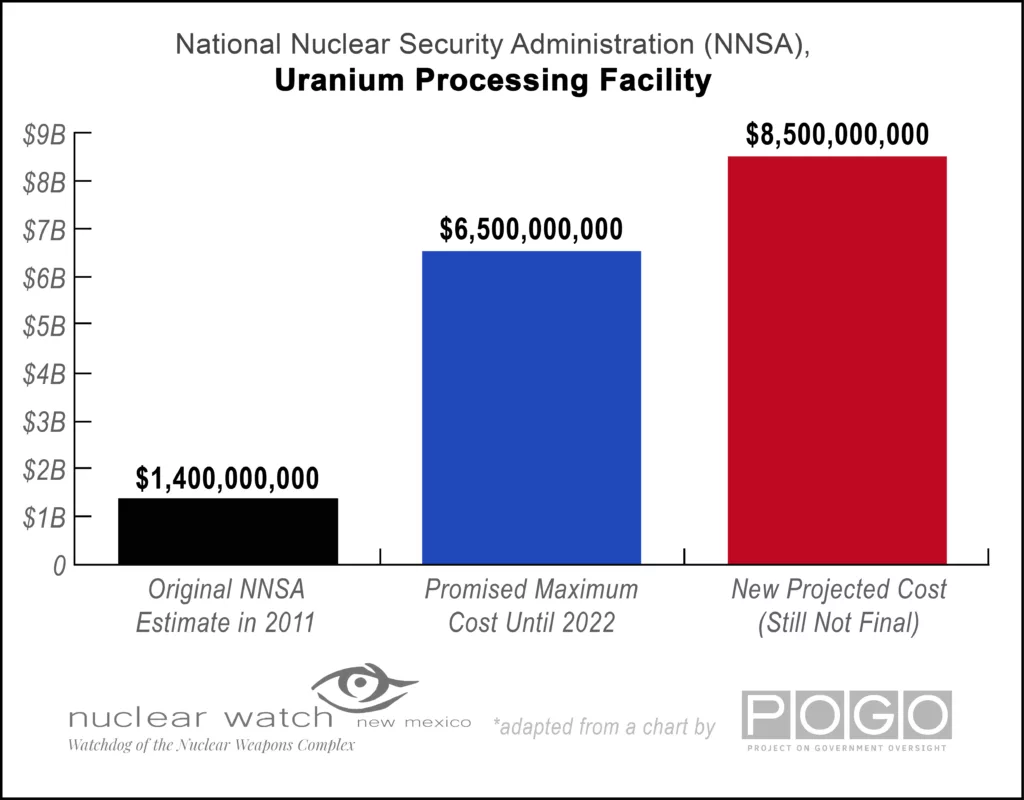 A current example is the Uranium Processing Facility (UPF) at the Y-12 Plant near Oak Ridge, Tennessee, originally estimated in 2011 to cost $1.4 to $3.5 billion. After costs started going through the roof, NNSA and Senator Lamar Alexander (R.-TN), then-chair of Senate Energy and Water Appropriations, swore that UPF would never go over $6.5 billion. But even after eliminating non-nuclear weapons production missions and a formal decision to continue operations at two old, unsafe buildings slated for replacement, the Uranium Processing Facility is now estimated to cost $8.5 billion. However, even that is not the final price, as NNSA is still to “rebaseline” UPF costs at some unspecified date.
A current example is the Uranium Processing Facility (UPF) at the Y-12 Plant near Oak Ridge, Tennessee, originally estimated in 2011 to cost $1.4 to $3.5 billion. After costs started going through the roof, NNSA and Senator Lamar Alexander (R.-TN), then-chair of Senate Energy and Water Appropriations, swore that UPF would never go over $6.5 billion. But even after eliminating non-nuclear weapons production missions and a formal decision to continue operations at two old, unsafe buildings slated for replacement, the Uranium Processing Facility is now estimated to cost $8.5 billion. However, even that is not the final price, as NNSA is still to “rebaseline” UPF costs at some unspecified date.
PLUTONIUM PIT PRODUCTION BRIEFING
Jay Coghlan, Nuclear Watch New Mexico January 17, 2023 | Email
GAO report: NNSA Does Not Have a Comprehensive Schedule or Cost Estimate for Pit Production Capability, January 12, 2023, gao.gov/products/gao-23-104661
- “NNSA’s Plutonium Pit Production Scope of Work Includes Dozens of Programs, Projects, and Other Activities Managed by Multiple NNSA Offices at Multiple Sites.” p. 19
- “NNSA Does Not Have a Comprehensive Schedule or Cost Estimate for Establishing its Pit Production Capability.” p. 40
- They [NNSA officials] said they did not want to introduce uncertainty about dates and wanted to avoid releasing preliminary or unpalatable information that was subject to change.” pp. 40-41
- “NNSA will have spent billions of dollars without having an overall idea of total program costs, or when program objectives, to include the capability to produce 80 pits per year, will be reached.” pp. 55-56
The Need for Independent Pit Aging Studies
June 16, 2022 | FACT SHEETS
Summary: The United States is aggressively expanding the production of plutonium “pit” bomb cores to at least 80 pits per year, which the Pentagon has called the number one issue in its $1.7 trillion plan to “modernize” nuclear forces. The average age of plutonium pits is around 40 years. Los Alamos Lab Director Thom Mason has said that “The best way to deal with this dilemma [of uncertainty about aging effects] is to take it off the table. We do that by making new pits, immediately.” Thus, he justifies spending tens of billions of dollars, creating additional occupational and public risks, generating more radioactive wastes with uncertain disposal pathways, fundamentally transforming the Lab into a nuclear weapons production site and fueling the increasingly dangerous new nuclear arms race.
But does independent review of pit aging data support this need to immediately produce new pits? The answer is no given that independent experts concluded in 2006 that pits last at least a century with no determined end date. Further, no future pit production is scheduled to maintain the safety and reliability of the existing nuclear weapons stockpile – it is all for speculative new designs which could raise reliability issues or even prompt the U.S. to resume testing.
Groups Fire Back at Feds’ Move to Dismiss Plutonium Pit Lawsuit
Federal agencies continue to reject a full review of the public safety and environmental risks of producing nuclear bomb cores at multiple DOE sites.
Jay Coghlan, director of Nuclear Watch New Mexico, commented, “The government has yet to explain to American taxpayers why it will spend more than $50 billion to build new plutonium pit bomb cores for new-design nuclear weapons when we already have thousands of existing pits proven to be reliable for a century or more. This has nothing to do with maintaining the safety and reliability of the existing stockpile and everything to do with building up a new nuclear arms race that will threaten the entire world.”
SRS WATCH / EIN PRESSWIRE October 26, 2021
AIKEN, SOUTH CAROLINA — Public interest groups shot back at the U.S. Department of Energy and the National Nuclear Security Administration’s attempt to suppress a lawsuit seeking a comprehensive environmental review of the agencies’ plans to produce large quantities of nuclear bomb cores, or plutonium pits, at DOE sites in New Mexico and South Carolina.
MEDIA ADVISORY – South Carolina Environmental Law Project and Nuclear Watchdogs Hold Virtual Press Conference
WHAT:
Public interest groups will hold a press conference for a major announcement of a forthcoming legal action as the U.S. Department of Energy and the National Nuclear Security Administration forge ahead with plans to drastically expand production of plutonium pits, the cores of nuclear weapons, at the Savannah River Site in South Carolina and the Los Alamos National Lab in New Mexico. The legal action follows previous unanswered requests from the groups to DOE and NNSA as seen in correspondence in February and April.
Biden Continues Trump’s Bloated Nuclear Weapons Budget
Will That Change in Future Years?
Santa Fe, NM – In a classic move that discouraged media coverage, the Department of Energy’s semi-autonomous National Nuclear Security Administration (NNSA) released its long delayed FY 2022 Congressional Budget Request around 7:30 pm EST Friday, May 28, at the very beginning of the long Memorial Day weekend.
Nuclear Watch New Mexico strongly opposed the 25% FY 2021 increase that the Trump Administration bequeathed to NNSA’s nuclear weapons programs. That massive increase was originally sold in testimony to Congress as essential to maintaining the nuclear deterrence but later revealed as necessary to cover NNSA cost overruns and blown schedules.[i]
NukeWatch Past Related Work
| 2020
March 10, 2020 Press Release Energy Dept. Nearly Triples Funding for Plutonium Pit Production Cuts Cleanup in Half But Refuses to Complete New Env. Impact Statement for Los Alamos Lab Santa Fe, NM – Today the Department of Energy’s semi-autonomous nuclear weapons agency, the National Nuclear Security Administration (NNSA), announced that it will not complete a new site-wide environmental impact statement for the Los Alamos National Laboratory (LANL). The last site-wide environmental impact statement was in 2008. April 3, 2020 Press Release DOE Ignores COVID-19 Threat, Diverts Resources to Planning for Nuclear War by Releasing Draft Environmental Study on SRS Plutonium Bomb Plant Today, in the middle of the growing coronavirus pandemic, the U.S. Department of Energy ignored the real national crisis and irresponsibly shifted its focus to planning for nuclear war, revealing plans to construct a Plutonium Bomb Plant (PBP) at the Savannah River Site (SRS) in South Carolina. April 21, 2020 Press Release >120 Groups and Individuals Ask Udall and Heinrich to Extend Public Comment Period on Los Alamos Lab Plutonium Bomb Core Production Santa Fe, NM – Today, on behalf of more than 120 groups and individuals, Nuclear Watch New Mexico sent a letter to New Mexico Senators Tom Udall and Martin Heinrich. It asks them to act upon their own words and demand that the public comment period be extended for plutonium “pit” bomb core production that the National Nuclear Security Administration (NNSA) is fast tracking during the coronavirus epidemic. As sitting members of the Senate Appropriations and Armed Services Committees, Udall and Heinrich are in strong positions to make that demand of NNSA. May 6, 2020 Press Release DOE Repeatedly Asks Safety Board for Time Extensions, Los Alamos Lab Asked for >150 Cleanup Milestone Extensions, But During Pandemic NNSA Rejects NM Senators’ Request for Extension of Public Comment on Plutonium Bomb Core Production Santa Fe, NM – Lisa Gordon-Hagerty, head of the National Nuclear Security Administration (NNSA), has rejected a request by New Mexico Senators Tom Udall and Martin Heinrich to extend the public comment period on expanded plutonium “pit” bomb core production because of the COVID-19 pandemic. In contrast, even in normal times NNSA and its parent Department of Energy routinely ask other government agencies for major time extensions when it comes to cleanup and independent oversight. Read/Download the Full Press Release HERE June 24, 2020 Press Release WATCHDOG GROUPS FILE LEGAL PETITION WITH ENERGY DEPT: Allege Agency is Slow Walking “Record of Decision” Re: Plutonium Bomb Core Production to Prevent Judicial Review; Stage Set for Litigation on Expanded Production Today, legal counsel for the public interest groups Nuclear Watch New Mexico, Tri-Valley Communities Against a Radioactive Environment, Savannah River Site Watch and the Natural Resources Defense Council took a significant step toward a potential legal challenge to the U.S. Department of Energy’s plans for expanded production of plutonium cores, or “pits,” for new-design nuclear weapons. Read/Download the Full Press Release HERE September 1, 2020 Press Release NNSA Slams Door Shut on Public Accountability While Ramming Through Expanded Plutonium “Pit” Bomb Core Production Santa Fe, NM – The National Nuclear Security Administration (NNSA) announced today that it will not prepare a new site-wide environmental impact statement for the Los Alamos National Laboratory (LANL). With this decision NNSA is slamming the door shut on public accountability while it rams through expanded plutonium “pit” bomb core production at the Lab. NNSA is relying upon outdated studies from 2008 to justify pit production. Since that time the agency has wasted billions of taxpayers’ dollars, another catastrophic wildfire threatened the Lab, serious deep groundwater contamination was discovered and LANL has had chronic nuclear safety incidences with plutonium that it can’t seem to fix. November 5, 2020 Press Release DOE Issues Controversial Decision to Pursue a Plutonium Bomb Plant (PBP) at Savannah River Site (SRS); Inadequate Environmental Review and Lack of Justification for Production of 50 or More “Pits” per Year to Modernize Entire Nuclear Weapons Stockpile Open to Legal Challenge The U.S. Department of Energy (DOE) today issued a formal decision that it will pursue a massive Plutonium Bomb Plant (PBP) at the DOE’s Savannah River Site (SRS) in South Carolina, in order to produce plutonium “pits,” or cores, for nuclear warheads. The provocative decision, which adds fuel to concerns about a new nuclear arms race with Russia and China, drew immediate opposition from public interest groups near DOE sites in South Carolina, New Mexico and California. 2019 June 10, 2019 Press Release Federal Government Meets Watchdogs’ Demand for Environmental Review of Expanded Plutonium Pit Production In a victory for transparency and legal compliance by the government, the U.S. Department of Energy’s National Nuclear Security Administration (NNSA) today published a “Notice of Intent” in the Federal Register to complete environmental reviews on its controversial proposal to expand plutonium “pit” production for new and refurbished nuclear weapons. Read/Download the Full Press Release HERE June 4, 2019 Press Release Noted Environmental Lawyers Warn Government Not to Expand Production of Plutonium Bomb Cores in Violation of National Environmental Policy Act and Public Review On behalf of three public interest organizations - Nuclear Watch New Mexico, Tri-Valley Communities Against a Radioactive Environment and Savannah River Site Watch – attorneys for the law firm of Meyer Glitzenstein & Eubanks and the Natural Resources Defense Council recently sent a 16-page letter to Lisa Gordon-Hagerty, head of the National Nuclear Security Administration (NNSA). The detailed letter warns the nuclear agency to not proceed with aggressive plans to expand plutonium pit production without first meeting its legal requirements for timely public review and comment under the National Environmental Policy Act. Read/Download the Full Press Release HERE May 31, 2019 Press Release Faulty Radioactive Liquid Waste Valves Raise Crucial Plutonium Pit Production and Safety Board Issues Last Wednesday, facility operations personnel entered a service room and noticed a leak emanating from a valve on the radioactive liquid waste (RLW) system. Upon subsequent visual inspection by a radiological control technician, RLUOB engineers believe that this valve, and 6 similar valves, may be constructed of carbon steel. The RLW system handles radioactive liquid waste streams from chemistry operations that include nitric and hydrochloric acids—carbon steel valves would be incompatible with these solutions. The suspect valves are also in contact with stainless steel piping, which would create another corrosion mechanism. RLUOB management plans to drain the affected piping sections and develop a work package to replace all of the suspect valves. They will also confirm the valve materials and if shown to be incorrect, investigate the cause of this failure in the design, procurement, and installation processes. The valves were installed in 2013 as part of a modification to add straining and sampling capabilities that were not in the included in the original design. [Please note that DNFSB reports are posted a few weeks later than dated.] This immediately raises two crucial issues: 1) the National Nuclear Security Administration’s (NNSA’s) plans for expanded plutonium pit production; and 2) the current attempt by the Department of Energy to restrict Safety Board access to its nuclear weapons facilities. Read/Download the Full Press Release HERE |
| 2018
November 16, 2018 Fact Sheet Expanded Plutonium Pit Production for U.S. Nuclear Weapons Plutonium pits are the radioactive cores or “triggers” of nuclear weapons. Their production has always been a chokepoint of resumed industrial-scale U.S. nuclear weapons production ever since a 1989 FBI raid investigating environmental crimes shut down the Rocky Flats Plant near Denver. In 1997 the mission of plutonium pit production was officially transferred to its birthplace, the Los Alamos National Laboratory (LANL) in northern New Mexico, but officially capped at not more than 20 pits per year. However, in 2015 Congress required expanded pit production by 2030 whether or not the existing nuclear weapons stockpile actually needs it. This will support new military capabilities for nuclear weapons and their potential use. Read/Download the full fact sheet pdf HERE
Watchdog Groups Claim Nuclear Agency is Moving Forward to Manufacture New Plutonium Bomb Cores in Violation of National Environmental Law and Public Review Nuclear Watch New Mexico, Savannah River Site Watch, and Tri-Valley CAREs sent a letter of demand to the U.S. Department of Energy’s National Nuclear Security Administration (NNSA) to inform the government that its plan to quadruple the production rate of plutonium bomb cores is out of compliance with the National Environmental Policy Act (NEPA). NNSA’s premature plan to quadruple the production rate of plutonium bomb cores (“pits”), the heart of all US nuclear weapons, is out of compliance with requisite environmental law, the groups argue, as NNSA has failed to undertake a legally-mandated programmatic review and hold required public hearings. View/Download the entire press release HERE |



